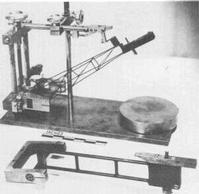


Chapter 9
I Introduction
II The Australian Chemical Industry
i Beginnings 1865-1919
ii Fertilisers
iii Raw materials from gasworks and coke ovens
iv The beginnings of industrial chemical research - in the sugar industry
v Explosives
III Pharmaceuticals
IV Chemists In Other Industries
V The Dawn Of Modern Chemical Industry - High Pressure Synthesis
VI The Growth Of Synthetic Chemicals - Concentration, Rationalisation And International Links
VII Australian Industrial Chemical Research Laboratories
VIII The Plastics Industry
IX The Paint Industry
X Acknowledgements
References
Index
Search
Help
Contact us

An unexplained explosion at the ICI Australia Ltd. factory at Deer Park suggested that nitroglycerine was more sensitive than theoretically expected. Friction was suspected as one of the many potential causes; hence ICI Australia handed the problem to Australia's foremost expert on friction, Dr. F. P. Bowden of the CSIRO Lubricants and Bearing Section, later to become the Division of Tribophysics. What ensued was a classical case of science following technology, explaining empirical phenomena and in so doing promoting a step change in practical technology.
F. P. Bowden and his co-workers,[40][41][42] with some help from ICI Australia Research Laboratories (A. E. Finn) had discovered' . . . the profound effect which minute bubbles of included gas have on the impact sensitivity of the explosives . . . ' and explained the phenomenon with great clarity as an effect of ' . . . adiabatic compression and heating of the entrapped bubble . . . ' (Fig. 8). Papers by Mulcahy et al.[43][44][45] provided elegant evidence of the mode of propagation. The immediate consequences of these discoveries were not dramatic, they merely contributed to increased understanding and safety. Later Bowden and his Australian co-worker Yoffe in the UK{46} amplified these findings and the 'bubble theory' became part of scientific explosives folklore. It was first applied by ICI U.K. Nobel Division, but acquired technical importance with the emergence of ammonium nitrate watergels between 1967 and 1982, when ammonium nitrate based emulsion blasting agents were developed in Australia and particularly in 1982, when ICI Australia produced a range of emulsions which were improved by the incorporation of stabilised gas bubbles, 'the emulsion gassing technique'.

The ammonium nitrate revolution
The manufacture of ammonium nitrate (AN) is part of the story of the dawn of the modern chemical industry (see pp 39-42) and even of petrochemicals. The conversion of fertiliser grade ammonium nitrate into an industrial explosive is almost a separate story. It is fascinating, because it amounted to the third revolution in explosives; because by the time it occurred -1950-1980 -Australia had fully developed industrial research laboratories and consequently contributed a great deal to it; and fascinating as a record of the nature of many 'revolutionary' discoveries which in reality are a complex interaction between practitioners in the field, industrial research teams, associated and competing international companies and academics turned industrialists.
The explosive properties of nitrates had, of course, been known for centuries. In 1867 in Sweden C. J. Ohisson and J. H. Norrbin had patented a mixture of AN with carbonaceous material;[47] Du Font introduced an ammonium nitrate based explosive, 'Nitramon', without much success in 1935 and in several industrial accidents (Ludwigshafen 1921, Texas City 1947) large explosions had demonstrated its power dramatically. In all cases the presence of small amounts of organic material was suspected as the cause. It is claimed that in 1952 Robert W. Akre,[48] a salesman for the Hercules Powder Company, was prompted by the Texas City disaster to explore AN/ ground coal mixtures with sporadic success. In 1955 he described a do-it-yourself blasting agent 'Akremite' at a meeting in Cleveland and soon similar blends were for sale, amongst others by the Spencer Chemical Company. Spencer chemists found out that diesel oil was a better source of carbon than coal because it was readily absorbed into the pores of AN drills, but they failed to pursue the concept. A mining manager and practical experimenter with AN, William F. LeClair, was prompted by a sales manager of Spencer's to add fuel oil to AN -and found it worked. A crude, simple, new blasting explosive was born.
Organisations in Australian Science at Work - I.C.I. Australia Ltd
People in Bright Sparcs - Bowden, F. P.; Finn, A. E.; Krebs, Friedrich; Mulcahy, M. F. R.; Vines, R. G.
 |
Australian Academy of Technological Sciences and Engineering |  |
© 1988 Print Edition pages 645 - 646, Online Edition 2000
Published by Australian Science and Technology Heritage Centre, using the Web Academic Resource Publisher
http://www.austehc.unimelb.edu.au/tia/612.html